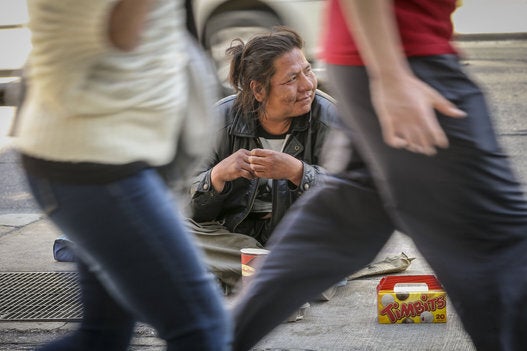
For six months, Matt's home was a park in downtown Toronto. In plummeting winter temperatures, he huddled under a bench and took sleeping medication to get through the night rather than brave one of the city's emergency shelters.
When a researcher with Toronto's Centre for Addiction and Mental Health (CAMH) asked Matt why he lived this way, he said, "It was safer for me to be popping pills and sleeping outside in minus-zero weather than be in the shelter system [because of] transphobia and homophobia."
Matt, 26, (his name has been changed) is transgendered. He's one of thousands of homeless lesbian, gay, bisexual or transgendered (LGBT) Canadian youth. About 14 per cent of young Canadians identify as LGBT (according to multiple surveys of Canadian high school students), but they make up a disproportionately large (as many as 40 per cent) number of youth living on our streets. Some cities, like Ottawa, estimate that fully half of their homeless youth population is LGBT.
Earlier this summer, Canada's first transitional housing dedicated to LGBT youth opened in Toronto -- the YMCA's Sprott House. Reading about this great initiative raised our awareness about an issue that needs to be on the radar of all Canadians -- the unacceptable rate of LGBT youth who have no place to call home.
LGBT youth become homeless for much of the same reasons as other young people--family conflict, abuse, mental health issues and addiction. But according to Alex Abramovich, the CAMH researcher who interviewed Matt, when you add LGBT identity into the mix, the severity of these issues multiplies.
For example, when a young person comes out as LGBT, pre-existing family conflicts are more likely to escalate dangerously, says Abramovich. "I can't tell you how many youth I've spoken to whose parents threatened to kill them when they came out," he says.
LGBT youth also experience higher rates of mental health and addiction issues, Abramovich adds, in large part because of discrimination.
Once on the streets, the researcher says LGBT young people find the shelter system is often not a safe space for them. They face bullying and risk violence from non-LGBT youth, and sadly sometimes even from shelter staff, who are supposed to be there to support them.
When the thermometer dropped below -20 Celsius, Matt finally fled the park to an emergency shelter. The shelter intake worker looked at Matt's ID, which identified him as female with his former name, and accused him of lying about who he was. When Matt tried to explain he was transitioning genders, the worker stared uncomprehendingly and assigned Matt to the women's dormitory.
"This is not a new problem. We've known about it for over 20 years, but we're only starting to respond to it," says Abramovich.
The province of Alberta, and some cities like Calgary and Toronto, are developing specific strategies to tackle LGBT youth homelessness. These include initiatives like mandatory training for all shelter staff who work with LGBT youth. One effort we find brilliant is the "Aurora host homes" program launched by the Calgary Boys and Girls Club in June. It provides training and financial support for compassionate families willing to take in homeless LGBT youth.
Sprott House manager Jeanette Blair says some of the ways it creates a safe space for LGBT youth include creating a welcoming atmosphere with LGBT-positive posters on the walls and eliminating dormitories so each resident has their own room with a private bathroom. "Common washrooms are places where trans youth face bullying and abuse," she explains.
Sadly, when Abramovich last heard Matt, the young transgendered man was living in a tiny, rundown apartment, operating a small business to make ends meet. Matt said it was still the park that felt most like home -- that was where he had always felt most safe.
No young person should live in fear. Sprott House and the Calgary host program show we can find compassionate solutions to give all LGBT Canadian youth a caring and safe place to live, and the support they need to fulfil their potential.
We need solutions like these in every city across the country if Canada is to remain a world leader in LGBT acceptance and rights.
Brothers Craig and Marc Kielburger founded a platform for social change that includes the international charity, Free The Children, the social enterprise, Me to We, and the youth empowerment movement, We Day.
MORE ON HUFFPOST:
